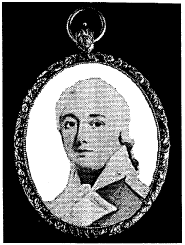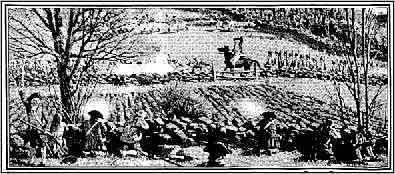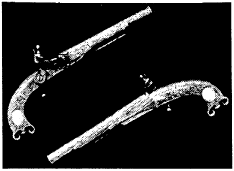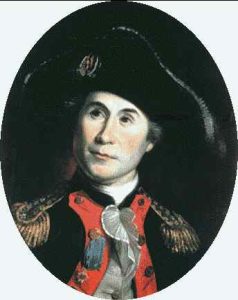Contents
Contents
We do not tend to remember lost wars or their casualties. The American Revolution is a case in point.
December 1997 marked the 275th anniversary of the birth of Major John Pitcairn of the Marines. A minister’s son from Dysart, near Kirkcaldy in Fife, he fell fighting bravely at Bunker Hill in 1775 but he is better known – and his valour still respected – among his former enemies in the USA than in Scotland.
John Pitcairn was baptised at Saint Serf’s Church in the then flourishing merchant port of Dysart, on December 28, 1722. He was the youngest surviving child of the Reverend David Pitcairn, MA (St. Andrews) and his wife Katharine Hamilton, both of well connected gentry families. Rev. David had served in the War of the Spanish Succession as chaplain to the Cameronian Regiment, under Colonels Lord Stair and Ferguson (great-granduncle of another Scottish hero of the Revolutionary War). He was minister of Dysart for some 50 years. The large Pitcairn family lived in the manse (minister’s house), right beside the old harbour on the Firth of Forth. Having grown up with the sea almost literally on the doorstep, John was commissioned Lieutenant in Cornwall’s 7th Marines in 1746. When the Marines were established permanently in 1755, he was confirmed in that rank. The following year, he was promoted to Captain. He was serving aboard HMS Lancaster in 1757, probably en route to Canada. In 1771, aged 48, he became a Major in the Chatham division.

There is no contemporary portrait of John. The 19th-century copy of the miniature here illustrated is in Lexington Museum. The uniform depicted is that of the 1790s. Possibly it is a posthumous idealisation, based on Trumbull’s 1786 history painting. Another possibility is that it shows John’s son Thomas, who died in 1797 aged only 42, and has been misidentified within the family. In his early 20s, John had married Elizabeth (Betty) Dalrymple (1724-1809), a distant cousin of his father’s old Colonel, the Earl of Stair. They had 6 sons (one dying in childhood) and 4 daughters. Their eldest son, David, followed his uncle, Dr. William Pitcairn, to become an eminent physician at St. Bartholomew’s Hospital in London. Robert became a midshipman, and in 1767 he was first to sight the Pacific Island named in his honour, but was lost at sea in January 1770, aged only 17. William joined his father in the Marines, while Thomas joined the army. Alexander, the baby, born in Kent, was only 7 when John died; eventually he entered the English legal profession. The daughters, Annie, Katharine, Johanna and Janet, married naval or army officers of good family.
In late November 1774, as unrest spread in the American colonies, Major Pitcairn arrived in Boston with some 600 Marines drawn from the Chatham, Portsmouth and Plymouth divisions.
He had to contend with a dispute between Admiral Graves1 and General Gage2 over landing them, and the fact that they had no proper winter clothing and equipment. He also wrote that the Admiralty should forbid the recruitment of men under 5′ 6″, since when he did get his Marines ashore, he was dismayed to see how poorly they compared when lined up next to the army.
The Plymouth Marines were particularly troublesome: “animals”, in John’s words! They had been sent out with inadequate officers, who could not keep order. Men were selling their kit to buy the lethal local rum, which killed a number of them. John spent some weeks living in barracks with them to keep them sober. It was only with regret and evident distaste that he resorted to flogging to enforce discipline. Both respected and popular, he succeeded in drilling the men into an effective force. His concern for his men’s welfare was reflected in one of his last acts before going to fight at Bunker Hill: writing a letter to obtain help for some destitute soldiers.
John was billeted with Francis Shaw, a fiercely anti-British tailor and neighbour of Paul Revere. Remarkably, he won the respect and affection of Shaw and other Bostonians, despite their political differences. Shaw was particularly grateful to John for preventing a duel between his teenage son Sam and young Lieutenant Wragg, who was also billeted with the family. Wragg had made some provocative remarks about Americans, and Sam (later a diplomat!) had responded by throwing wine on him. Fortunately, John was able to defuse the situation with his characteristic charm and wit. He was highly regarded for his integrity, honesty and sense of honour, and for dealing justly in disputes between the locals and the military. He attended Christ Church every Sabbath but during the rest of the week was noted for his profane language. He hosted socials at Shaw’s house, where British officers and locals, including Revere, could meet and exchange views in a civilised fashion. There was family company around, also: his sons William and Thomas, and his daughter Katharine’s husband, Captain Charles Cochrane3.
On April 19, 1775, John Pitcairn was second-in-command of the troops sent to destroy rebel stores in Concord. At Lexington Green, they came face-to-face with a body of armed American militia. John ordered his men not to fire and commanded the rebels to lay down their arms and disperse. Several shots rang out and despite Johns’ efforts, firing broke out on both sides. Several militiamen were killed. The American Revolutionary War had begun.
Their mission in Concord accomplished, the British came under heavy fire on the road back to Boston. John’s horse was shot and threw him. He was forced to march the rest of the way. Legend has it that his horse had taken with it his brace of richly decorated Scottish scroll-butt pistols, which were presented as a trophy to American leader Israel Putnam, who used them throughout the War! They are now displayed in Lexington. They were made by the famous John Murdoch of Doune. However, the crest on the escutcheon plate is not that of the Pitcairns, and it may be that there has been a mistake in identifying from whose horse they were taken. Putnam was allegedly carrying these pistols on June 17 at Bunker Hill. The British launched three assaults on the American position (actually on Breed’s Hill) at Charlestown, near Boston, and won the day – but at a hideous cost: 50 per cent killed and wounded. Among the casualties was John Pitcairn.
In the summer heat, he led his Marines – including his son, William (age 21), a Lieutenant, on foot up the hill for the final assault. While advancing, they crossed another line of infantry, who were being pushed back by heavy rebel fire. John told them to “Break and let the Marines through!”, and is said to have threatened to “bayonet the buggers” if they would not get out of the Marines’ way! He waved his sword and urged his men on: “Now, for the glory of the Marines!”
Then a musket ball struck him in the breast and he fell into William’s arms. The American artist John Trumbull depicted the scene in his famous 1786 painting of the battle, with Dr. David Pitcairn modelling for the studies of his late father, whom he greatly resembled, and Thomas for William, who had died young in 1779. The lad carried his wounded father on his back out of the line of fire, before returning to the battle. “I have lost my father!” he said. “We have all lost a father!” some of the Marines responded.
A boat took John back to Boston. He was put to bed in a house on Prince Street. He was fully conscious but guessed his chances were poor. With stoic courage – and without anaesthetics – he faced the 18 th century soldiers’ most feared enemy – the 18th-century doctor. The army surgeons were overworked because of the heavy casualties, so General Gage, anxious to save an officer he greatly valued, had sent his own physician, young Dr. Thomas Kast, to tend him. Firmly but courteously, John told the doctor not to touch him until he had put his affairs in order. Only then did he agree to have his wound examined. But when Dr. Kast pulled John’s waistcoat away from his chest, he suffered a massive hemorrhage. Although the bullet was removed and his wound dressed, he died a couple of hours later. He was 52.
Mourned by friend and foe alike, Major Pitcairn was buried in the crypt of Christ Church (the “Old North Church”) in Boston. The fatal bullet and his uniform buttons were returned to Betty and children.
In 1791, a coffin, said to be Johns’ was shipped to London for burial in the Church of St. Bartholomew the Less, in the vault belonging to his brother and son, the two Doctors Pitcairn. However, Boston tradition claims the wrong coffin was sent, either by mistake or because an unscrupulous Boston doctor and conman, Amos Winship, had deliberately duped Betty and Dr. William Pitcairn. If this is true, he remains in the city where he died.
John’s birthplace, the old manse of Dysart, was demolished over 100 years ago. All that survives is part of the courtyard wall, with its 16th-century lintel, beside the former Bay House. The old harbour, too, is long-gone, replaced in the 19 th century. Dysart itself, no longer a busy European trading port, has been all but swallowed up by neighbouring Kirkcaldy.
The marble plaque John erected to his parents’ memory in 1757-58 in St. Serfs was destroyed by vandals in the early 19th century after the church fell into ruin. Only a square of rough stonework in the east gable shows where it was attached to the wall.
Yet in America, Major John Pitcairn is still remembered as a decent, honourable man and a gallant enemy.
That he is almost forgotten in his home country is poignant indeed.
Footnotes
- Admiral Graves – Admiral Sir Samuel Graves (1713 – 1787). Commanded the Royal Naval Squadron at Boston in 1775.
- General Gage – Major General Thomas Gage (1719?- 1787) British Commander-in-Chief in North America relieved on October 10, 1775, by Major General William Howe.
- Charles Cochrane (1749 – 1781) – younger son of the Earl of Dundonald; later Major, and Cornwallis’ Aide-de -Camp. In South Carolina in 1780 he led his men into a “friendly fire” incident in which Major Patrick Ferguson was bayoneted. He was beheaded by a cannonball at Yorktown. Katharine Pitcairn later remarried.
- See Major Pitcairn’s Official Report on the Lexington-Concord battle below.
Major John Pitcairn’s Lexington Report
Boston Camp,
26th April, 1775
To: General Thomas Gage
Sir, As you are anxious to know the particulars that happened near and at Lexington in the 19th Inst agreeable to your desire, I will in as concise a manner as possible state the facts, for my time at present is so much employed, as to prevent a more particular narrative of the occurrences of that day.
Six companies of Light Infantry were detached by Lt Colo Smith to take possession of two bridges on the other side of Concord, near three in the Morning, when we were advanced within about two miles of Lexington, intelligence was received that about 500 men in arms were assembled, determined to oppose the Kings troops, and retard them in their march. On this intelligence, I mounted my horse, and galloped up to the six Light Companies. When I arrived at the head of the advance Company, two officers came and informed me, that a man of the rebels advanced from those that were assembled, had presented his musket and attempted to shoot them, but the piece flashed in the pan. On this I gave directions to the troops to move forward, but on no account to fire, or even attempt it without orders; when I arrived at the end of the Village, I observed drawn up upon a Green near 200 rebels; when I came within about 100 yards of them, they began to file off towards some stone walls on our right flank. The Light Infantry, observing this, ran after them. I instantly called to the soldiers not to fire, but surround and disarm them, and after several repetitions of those positive orders to the men, not to fire, etc. some of the rebels who had jumped over the wall fired four or five shots at the soldiers, which wounded a man of the Tenth and my horse was wounded in two places, from some quarter or other, and at the same time several shots were fired from a meeting house on our left. Upon this, without any order or regularity, the Light Infantry began a scattered fire, and continued in that situation for some little time, contrary to the repeated orders both of me and the officers that were present. It will be needless to mention what happened after, as I suppose Colo Smith hath given a particular account of it.
I am, Sir, Your Most Obedient
Humble Servant
John Pitcairn

Text and graphics re-published with permission of the author, Doctor Gilchrist; and Donald Norman Moran. Taken from “The Liberty Tree and Valley Compatriot” May 1998.


